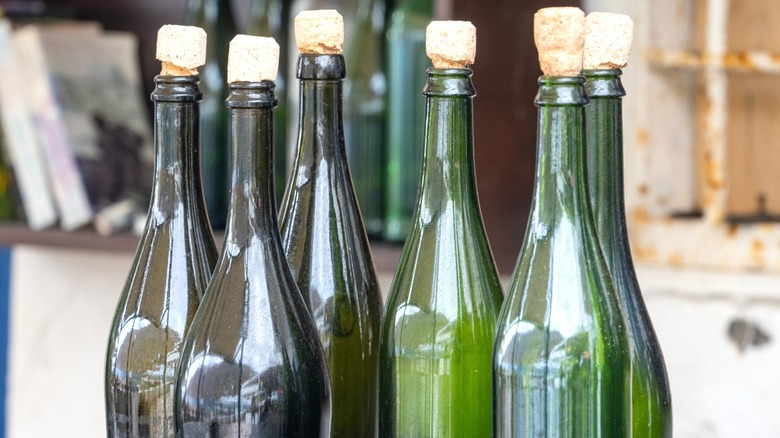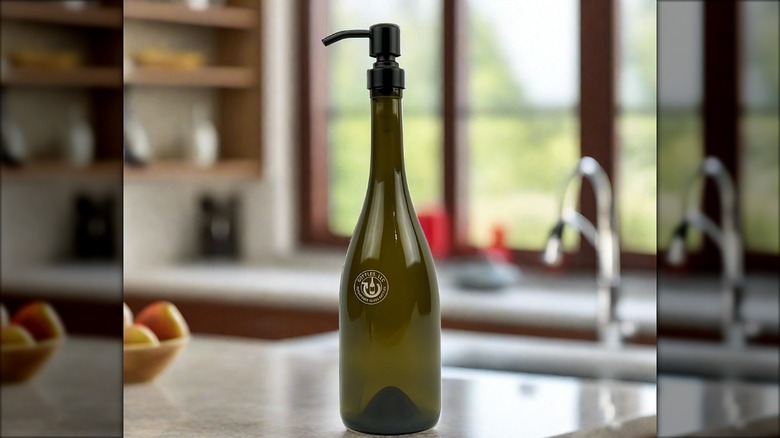Repurpose An Empty Wine Bottle Into A Stylish Soap Dispenser For Your Kitchen
We may receive a commission on purchases made from links.
With its limitless reusability, glass is one material that has no place going to waste in the trash bin. Whether it's an old pasta jar or a spent wine bottle, your options are to reduce, reuse, or recycle if you want to take the responsible, eco-friendly route with your glass containers. Unfortunately, only roughly ⅓ of glass gets recycled annually, offering little confidence for anyone tossing their containers in the blue bin. To be eco-friendly, the best thing you can do with your glass bottles is reuse them. When it comes to finding new functions for old wine bottles, you'll see there are all kinds of creative ways to upcycle empty wine bottles, including kitchen soap dispensers.
Giving your glass wine bottle a second life as a soap dispenser is a quick, simple, and inexpensive project. Apart from the glass bottle, you'll typically only need a pump head and adhesives to complete the project, so you may be able to pull this fashionable DIY together for under $15. Just make sure any materials you use won't rust or wear out from moisture exposure; it's going next to a sink, after all! In only a few short minutes, you'll have an upgrade to the typical plastic soap dispenser that will add a uniquely classy accent you'll be sure to love.
Easily turn an old wine bottle into a kitchen soap dispenser
Wine bottles come in various styles, but there's always a dispenser pump to match. For bottles with traditional corks, the conversion is easy. All you need are some cork stoppers like the Creative Hobbies Pump Dispenser Cork Stopper. You may be able to reuse the bottle's existing cork if it's in good condition. Drill a hole straight through the cork, and fit the pump straw through it until the pump cap sits atop the cork. Apply a bit of glue to keep the cork and pump connected. If you'd rather replace the cork, there are many ways to repurpose wine corks around the house.
For wine bottles with screw tops, you might be able to attach a standard twist-on pump, such as the Kapitan Soap Dispenser Pump Head Replacement. Most wine bottles use a cork with just under a 1-inch diameter, so a matching pump head of that size should supply a snug fit. Otherwise, you can connect the pump to the bottle with a collar ring, a threaded adapter that attaches to the bottle's sealing surface. Many pumps include collar rings, but you can buy pieces like CJH acrylic collar rings separately if you already have a pump head. Glue the ring to the top of the glass bottle with a heavy-duty glue appropriate for glass and plastic, such as a structural acrylic or epoxy. Let the glue set, and you can put the pump on and fill your soap-dispensing wine bottle.
Tips for your wine bottle soap dispenser
To make your new soap dispenser work in the kitchen, you may need to address minor details. Removing the label is a great idea for a minimalist look, but you may want to keep yours for a fun aesthetic. Next to the sink, labels will suffer plenty of water exposure that could wear them out, whether you keep the wine bottle's original wrap or replace it with your own chic homemade wine label. To keep it safe from moisture, cover the label with Mod Podge, acrylic sealant, polycrylic, or another water-resistant clear coat. Put painter's tape around the label edges to keep the sealant off the glass, and apply it in even coats. Remove the tape, and let the sealant dry before using the bottle.
With a long-necked wine bottle, another issue you may encounter with your soap dispenser is making the pump long enough to reach the bottom. One solution is installing a longer straw. Or, you could skip the pump altogether and use a pourer that will work for bottles of any height. Bottle pourers are inexpensive (this BALTRE two-piece spout set costs only $5.99 on Amazon), and their tapered stoppers allow them to fit most wine bottles. Clean your wine bottle before filling it with dish or hand soap. Press the stopper in as far as it will go to ensure a tight hold, and it's ready to use!

